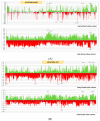Clinical and Molecular Comparative Study of Colorectal Cancer Based on Age-of-onset and Tumor Location: Two Main Criteria for Subclassifying Colorectal Cancer
- PMID: 30813366
- PMCID: PMC6413061
- DOI: 10.3390/ijms20040968
Clinical and Molecular Comparative Study of Colorectal Cancer Based on Age-of-onset and Tumor Location: Two Main Criteria for Subclassifying Colorectal Cancer
Abstract
Our aim was to characterize and validate that the location and age of onset of the tumor are both important criteria to classify colorectal cancer (CRC). We analyzed clinical and molecular characteristics of early-onset CRC (EOCRC) and late-onset CRC (LOCRC), and we compared each tumor location between both ages-of-onset. In right-sided colon tumors, early-onset cases showed extensive Lynch syndrome (LS) features, with a relatively low frequency of chromosomal instability (CIN), but a high CpG island methylation phenotype. Nevertheless, late-onset cases showed predominantly sporadic features and microsatellite instability cases due to BRAF mutations. In left colon cancers, the most reliable clinical features were the tendency to develop polyps as well as multiple primary CRC associated with the late-onset subset. Apart from the higher degree of CIN in left-sided early-onset cancers, differential copy number alterations were also observed. Differences among rectal cancers showed that early-onset rectal cancers were diagnosed at later stages, had less association with polyps, and more than half of them were associated with a familial LS component. Stratifying CRC according to both location and age-of-onset criteria is meaningful, not only because it correlates the resulting categories with certain molecular bases, but with the confirmation across larger studies, new therapeutical algorithms could be defined according to this subclassification.
Keywords: CpG island methylator phenotype; chromosomal instability; early-onset colorectal cancer; late-onset colorectal cancer; microsatellite instability; tumor location..
Conflict of interest statement
The authors declare no conflict of interest.
Figures


References
-
- Perea J., Alvaro E., Rodríguez Y., Gravalos C., Sánchez-Tomé E., Rivera B., Colina F., Carbonell P., González-Sarmiento R., Hidalgo M., et al. Approach to early-onset colorectal cancer: Clinicopathological, familial, molecular and immunohistochemical characteristics. World J. Gastroenterol. 2010;16:3697–3703. doi: 10.3748/wjg.v16.i29.3697. - DOI - PMC - PubMed
-
- Boardman L.A., Johnson R.A., Viker K.B., Hafner K.A., Jenkins R.B., Riegert-Johnson D.L., Smyrk T.C., Litzelman K., Seo S., Gangnon R.E., et al. Correlation of chromosomal instability, telomere length and telomere maintenance in microsatellite stable rectal cancer: A molecular subclass of rectal cancer. PLoS ONE. 2013;8:e80015. doi: 10.1371/journal.pone.0080015. - DOI - PMC - PubMed
Publication types
MeSH terms
Grants and funding
LinkOut - more resources
Full Text Sources
Medical
Research Materials

